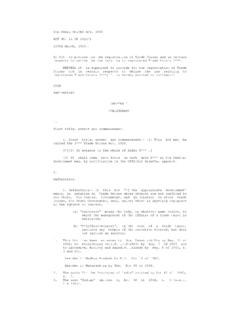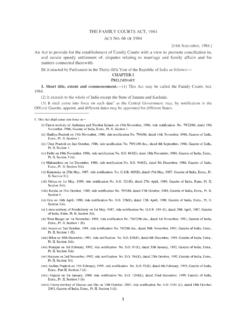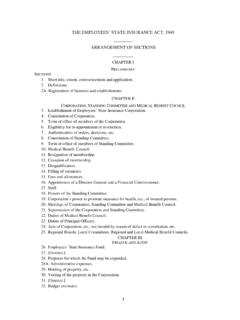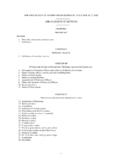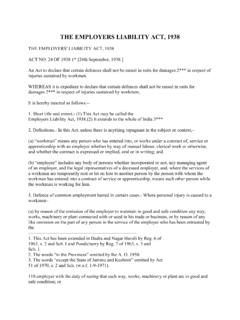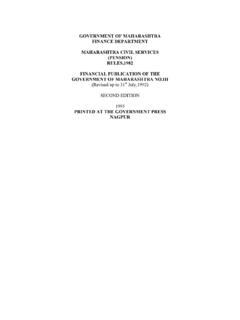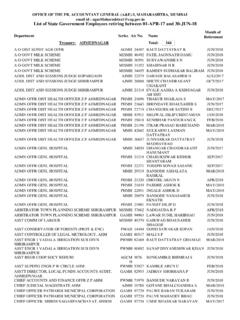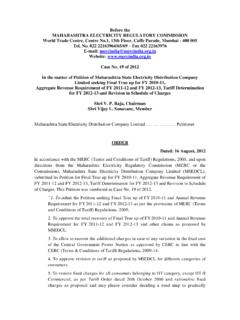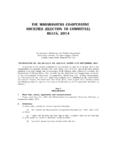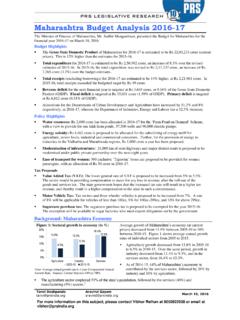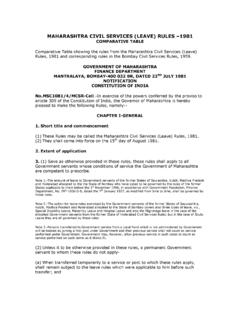Transcription of CHAPTER - 1 INTRODUCTION AND HISTORICAL BACKGROUND
1 1 CHAPTER - 1 INTRODUCTION AND HISTORICAL Group or in-short SHG is now a well-known concept. It is now almost two-decade old. It is reported that the SHGs have a role in hastening country s economicdevelopment. SHGs have now evolved as a , members of the SHGs are women. Consequently, participation of women in thecountry s economic development is increasing. They also play an important role in elevatingthe economic status of their families. This has led boost to the process of women can trace the origin of the concept of SHGs in Micro-finance institutes of BangladeshBangladesh has been acknowledged as a pioneer in the field of micro-finance. Yunus, Professor of Economics in Chitgaon University of Bangladesh, was an initiatorof an action research project Grameen Bank.
2 The project started in 1976 and it was formally recognised as a bank through anordinance, issued by the government in 1983. Even then it does not have a scheduledstatus from the Central bank of the country, the Bangladesh Bank. The Grameen Bankprovides loans to the landless poor, particularly women, to promote self-employment. Atthe end of December 2001, it had a membership of lakh and cumulative micro-creditdisbursements of Tk Rural Advancement Committee (BRAC), Association for Social Advancement(ASA) and PROSHIKA1 are the other principal Micro-credit Finance Institutions (MFIs)operating for over two decades and their activities are spread in all the districts of thatcountry. BRAC isBRAC is the largest NGO of Bangladesh with a total membership of Initially set up in 1972 as a relief organisation, it now addresses the issues of poverty1 PROSHIKA,PROSHIKA derives its name from three Bengali words, namely Proshikshan (training), Shiksha(education) and Kaj (action).
3 2alleviation and empowerment of poor, especially women, in the rural areas of the institute also works in the field of literacy, legal education and human rights. BRAC hasworked significantly in the fields of education, health, nutrition and other support is also active in the areas of literacy, environment, health and organisationbuilding, while ASA and Grameen Bank are pure micro-finance practices of these institutions revolve around five basic , these institutions primarily have women as their target group. Secondly, they adoptgroup approach for achieving their targets. The group approach focuses on organising thepeople into small groups and then introducing them to the facility of micro-financing. TheMFIs of Bangladesh place a great deal of importance to group solidarity and , savings are an essential precondition in all these MFIs for availing credit from , the officials of the Bangladesh MFIs remain present in the weekly meetings of thegroups and collect the savings, update the pass books and even disburse the loans, andlastly, the systems and procedures of the MFIs are quite simple and in tune with therequirements and capabilities of their ScenarioIndia has adopted the Bangladesh s model in a modified form.
4 To alleviate the povertyand to empower the women, the micro-finance has emerged as a powerful instrument inthe new economy. With availability of micro-finance, self-help groups (SHGs) and creditmanagement groups have also started in India. And thus the movement of SHG has spreadout in India, banks are the predominant agency for delivery of micro-credit. In 1970, IlabenBhat, founder member of SEWA (Self Employed Women s Association) in Ahmadabad, haddeveloped a concept of women and micro-finance . The Annapurna Mahila Mandal inMaharashtra and Working Women s Forum in Tamilnadu and many National Bank forAgriculture and Rural Development (NABARD)-sponsored groups have followed the path laiddown by SEWA . SEWA is a trade union of poor, self-employed women 1987 Mysore Resettlement and Development Agency (MYRADA) has promotedCredit Management Groups (CMGs).
5 CMGs are similar to self-help groups. The basic featuresof this concept promoted by MYRADA are: 1] Affinity, 2] Voluntarism, 3] Homogeneity and4] Membership should be limited to15-20 persons. Aim of the CMG is to bestow socialempowerment to 1991-92 NABARD started promoting self-help groups on a large scale. And it wasthe real take-off point for the SHG movement . In 1993, the Reserve Bank of India alsoallowed SHGs to open saving accounts in banks. Facility of availing bank services was amajor boost to the movement of SHG was nourished innourished in the states of Gujarat, maharashtra ,Andhra Pradesh, Rajasthan, Tamilnadu and nearly 560 banks like NABARD, Bank of maharashtra , State Bank of India, Co-operative Banks, Regional rural banks, the Government institutions like maharashtra ArthikVikas Mahamandal (MAVIM), District Rural Devlopment Agency (DRDA), Municipal corporationsand more than 3,024 NGOs are collectively and actively involved in the promotion of model in IndiaIn India three different models of linkage of SHGs to the financial institutions haveemerged.
6 They are:lBanks, themselves, form and finance the are formed by NGOs and other agencies but financed Byby finance SHGs with NGOs and other agencies as financial second model is the most popular model. Almost three-fourths of all the SHGscome under this model. Only 20% of the SHGs are covered under the first and 8% underthe third model SHG Movement in MaharashtraThe concept of SHG was not new to maharashtra . Beginning with a tiny amount ofonly 25 paise, the women of maharashtra from Amaravati District had established one SHGlong back in in 1988, Chaitanya Gramin Mahila Bal Yuvak Sanstha started promoting SHGsin Pune District, Southern part of India, SADHAN , DHAN foundation and ASA worked to promoteSHGs. But their thrust was on economic aspects only.
7 Whereas in maharashtra , the NGOsnot only have catered to the economic needs of the participants, but also involved in theprocess of social development. Aim of Chaitanya is also the same to empower the womenin both ways, economically and socially. Presently, numerous NGOs and governmentalinstitutions promote SHGs on a large Statistics is given in the following tables:Table 1 : Number of SHGs formed by various agencies Physical AchievementsNumber of new SHGs formed by formal agencies during 2003-0492774 Number of new SHGs formed by NGOs during 2003-0410622890 percent SHGs are comprised only of women 2 : Pattern of PartnershipNumber of participating banks560 Number of branches of banks lending to SHGs35,294 Commercial banks48 Regional rural banks (RRBs)196Co-operatives316 Number of participating NGO and other agencies3,024 Table 3 : Geographical Spread of SHG ActivityNumber of States & Union Territories31 Number of districts563 Table 4.
8 SHG - Bank Linkage Programmes - Highlights March 2001 to March 2004 Percentage of the Total target for the 2001 March 2002 March 2003 March formed and financedby bank13%16%20%20% formed by formalagencies and NGO s butdirectly financed by banks76%5%72%72% financed by banksthrough NGO s11%9%8%8%[(Ref: Progress of SHG Bank linkage in India 2003 2004 (NABARD)] of SHG in the process of empowerment of womenThe year 1975 was declared as a year for women . Also, the decade from 1975 to1985 was declared as a decade for women . During this period, the movement forempowerment of women received a fillip. The importance of role of women, which consists50% of the society, was highlighted in this span of period. It was emphasised that womanshould get the same opportunities as that to year 2001 was declared as a year of women empowerment.)
9 Efforts were beingmade in the direction that women should have a role in all walks of life; and specialprovisions should be made in the budget for activities related to the development ofwomen. Many schemes were planned and started to be executed, at government level, inrespect of women education, laws regarding prevention of atrocities on women, their5participation in economic and political spheres etc. At this juncture, SHG movement alsostarted and in a way journey towards women empowerment is empowerment?Empowerment is a process of change by which individuals or groups gain power andability to take control over their lives. It involves access to resources, resulting into increasedparticipation in decision-making and bargaining power and increased control over benefits,resources and own life, increased self-confidence, self-esteem and self-respect, increasedwell means empowerment is a multi-fold concept that includes economic, social &political )Economic empowermentFor economic empowerment it is necessary for a woman to have access to andcontrol over productive resources and to ensure some degree of financial to the report by National Commission for Women (NCW) - (Status of women2001), in India, women work for longer hours than men do.
10 The proportion of unpaidactivities to the total activities is 51% for females as compared to only 33% for males. Overand above this unpaid work, they have the responsibilities of caring for household whichinvolves cooking, cleaning, fetching water and fuel, collecting fodder for the cattle,protecting the environment and providing voluntary assistance to vulnerable anddisadvantaged individuals in the shows that though there is still a long journey ahead towards womenempowerment. To achieve the goal, there is an urgent need of change in the mindset ofthe entire rural region, where winds of changes development have yet to reach and basiceconomic needs are yet to be fulfilled,. Tthe main source of employment for women is farmlabour. But this does not fulfil all their needs.


